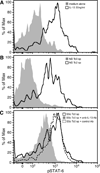Interleukin-13-producing CD8+ T cells mediate dermal fibrosis in patients with systemic sclerosis
- PMID: 23001877
- PMCID: PMC3535505
- DOI: 10.1002/art.37706
Interleukin-13-producing CD8+ T cells mediate dermal fibrosis in patients with systemic sclerosis
Abstract
Objective: Fibrosis is a major contributor to morbidity and mortality in systemic sclerosis (SSc). T cells are the predominant inflammatory infiltrate in affected tissue and are thought to produce cytokines that drive the synthesis of extracellular matrix (ECM) proteins by fibroblasts, resulting in excessive fibrosis. We have previously shown that aberrant interleukin-13 (IL-13) production by peripheral blood effector CD8+ T cells from SSc patients correlates with the extent of skin fibrosis. The present study was undertaken to investigate the role of IL-13 production by CD8+ T cells in dermal fibrosis, an early and specific manifestation of SSc.
Methods: ECM protein production by normal dermal fibroblasts cocultured with SSc CD8+ T cell supernatants was determined by quantitative polymerase chain reaction and Western blotting. Skin-homing receptor expression and IL-13 production by CD8+ T cells in the peripheral blood of SSc patients were measured by flow cytometry. IL-13+ and CD8+ cells in sclerotic skin were identified by immunohistochemistry.
Results: IL-13-producing circulating CD8+ T cells from patients with SSc expressed skin-homing receptors and induced a profibrotic phenotype in normal dermal fibroblasts, which was inhibited by an anti-IL-13 antibody. High numbers of CD8+ T cells and IL-13+ cells were found in the skin lesions of SSc patients, particularly during the early inflammatory phase of the disease.
Conclusion: These findings show that IL-13-producing CD8+ T cells are directly involved in modulating dermal fibrosis in SSc. The demonstration that CD8+ T cells homing to the skin early in the course of SSc are associated with accumulation of IL-13 is an important mechanistic contribution to the understanding of the pathogenesis of dermal fibrosis in SSc and may represent a potential target for therapeutic intervention.
Copyright © 2013 by the American College of Rheumatology.
Conflict of interest statement
The authors declare that no competing financial interests or conflicts exist.
Figures






References
-
- Gabrielli A, Avvedimento EV, Krieg T. Scleroderma. The New England journal of medicine. 2009;360:1989–2003. - PubMed
-
- Jinnin M. Mechanisms of skin fibrosis in systemic sclerosis. J Dermatol. 2010;37:11–25. - PubMed
-
- Roumm AD, Whiteside TL, Medsger TA, Jr, Rodnan GP. Lymphocytes in the skin of patients with progressive systemic sclerosis. Quantification, subtyping, and clinical correlations. Arthritis Rheum. 1984;27:645–653. - PubMed
-
- Fleischmajer R, Perlish JS, Reeves JR. Cellular infiltrates in scleroderma skin. Arthritis Rheum. 1977;20:975–984. - PubMed
Publication types
MeSH terms
Substances
Grants and funding
LinkOut - more resources
Full Text Sources
Other Literature Sources
Medical
Research Materials

